All 6 Oaxaca Pueblos Mágicos: The Ultimate Guide [2024]
Disclosure: This post may contain affiliate links, meaning that I may get a small commission if you decide to make a purchase through my links, at no cost to you.
You’ve probably heard that there are lots of things to do and see in Oaxaca, but have you heard of the Oaxaca Pueblos Mágicos?
Pueblos Mágico (literally “magic town”) is a designation given to certain small towns in Mexico that have a particular magical attraction, be it from their historic architecture, their culture or otherwise.
There are only six Oaxaca Pueblos Mágicos, and so far they’re still a well-kept secret even after several years of receiving the prestigious designation. In fact, a lot of people miss out entirely on these Mexican treasures, which is a shame, because a few of them are quite close to Oaxaca City.
To make sure that you don’t miss out, I’ve set out below a comprehensive guide to everything that you need to know about the six Oaxaca Pueblos Mágicos.
Let’s get right into it.
Oaxaca Pueblos Mágicos: tHE ULTIMATE GUIDE
What Are Pueblos Mágicos?

Let’s start with what the Pueblos Mágicos actually are, just in case you’ve never heard of them before.
Pueblos Mágicos are Mexican towns designated as “Pueblos Mágicos (literally Magic Towns)” by the Mexican Secretary of Tourism. According to the Secretary of Tourism, Pueblos Mágicos have the following characteristics:
- they have legends and symbols;
- many have been places of transcending events in Mexican history;
- they display Mexico’s national identity; and/or
- they have magic that emanates from their attractions.
The program began in 2001 with the goal of increasing economic development and quality of life of local Mexican towns. By drawing the attention of more visitors, those smaller towns can share in the economic benefits of tourism that might otherwise primarily go to the larger cities.
At the local level, that means keeping jobs in the local community and helping the community to support small businesses. It’s basically marketing at the local level carried out by the government at the federal level.
There were initially four Pueblos Mágicos in the first year of the program’s creation. As of July 2023, there are now 177 Pueblos Mágicos in Mexico, with a few new towns being added each year.
There are six Oaxaca Pueblos Mágicos, and I’ve linked them to the section below for you in case you want to jump right to any of them directly. They are:
- San Pedro y San Pablo Teposcolula;
- Huautla de Jiménez;
- Capulálpam de Méndez;
- San Pablo Villa de Mitla;
- Santa Catarina Juquila; and
- Mazunte.
Before we jump into the details on each of the Oaxaca Pueblos Mágicos, I’ve set out a very brief introduction to Oaxaca for those of you that aren’t familiar with it.
Oaxaca Pueblos Mágicos: tHE ULTIMATE GUIDE
Where is Oaxaca?
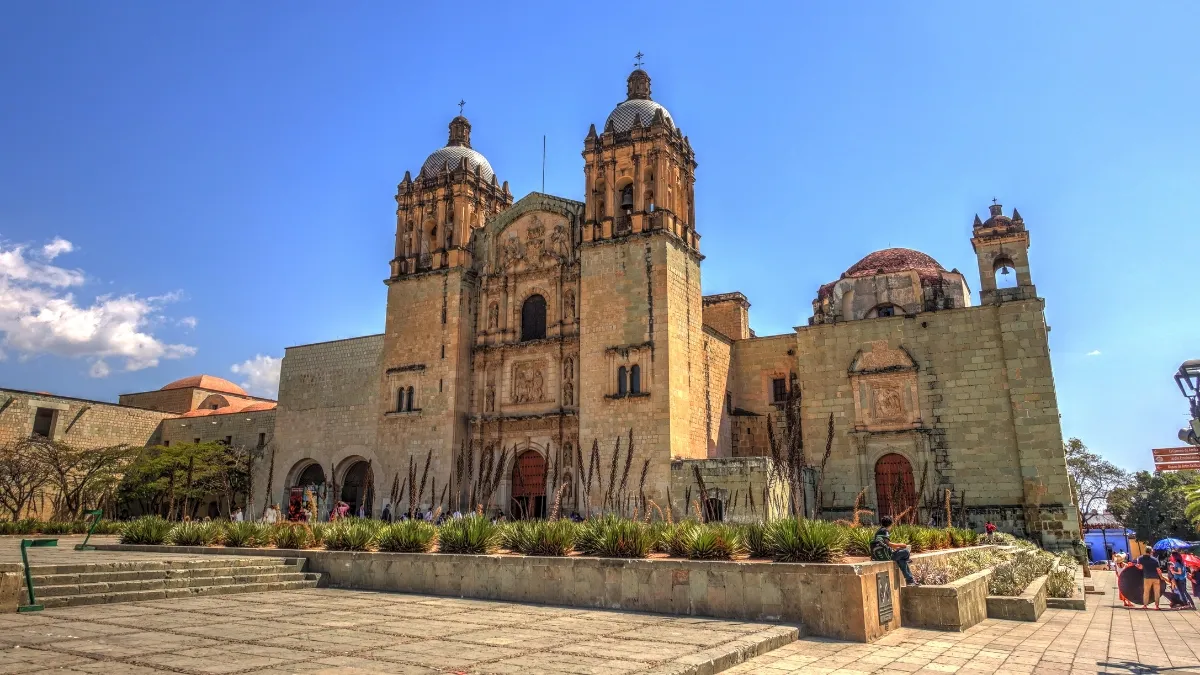
If you’re not familiar with Oaxaca, it’s a large region of southern Mexico, bound to the south by the Pacific Ocean. It neighbours the state of Chiapas to the east, the states of Puebla and Veracruz to the north, and the state of Guerrero to the west.
Oaxaca is known for having a diverse geography, which you’ll see in the diversity of the Oaxaca Pueblos Mágicos. Depending on what part of the state you are visiting, you could be high up in the mountains, down in the dry semi-desert valley regions, or in one of the idyllic beachside villages spread out along the 370 miles of beautiful pacific Ocean coastline.
Its capital city is Oaxaca City, more formally known as Oaxaca de Juárez. It’s the cultural center of the state and is situated in the Oaxaca Valley, surrounded by stunning mountains and beautiful landscapes.
The historic center of Oaxaca City is a UNESCO World Heritage Site and is adorned with beautiful cobblestoned streets, breathtaking colonial architecture, and colorful markets. The city is also known for its truly unique festivals including the Day of the Dead festival, which Oaxaca is known for celebrating lavishly.
In addition to the attractions within the city, you can also quickly reach some of the Oaxaca Pueblos Mágicos, as you’ll see shortly.
Oaxaca Pueblos Mágicos: tHE ULTIMATE GUIDE
Where Can You Find the Oaxaca Pueblos Mágicos?
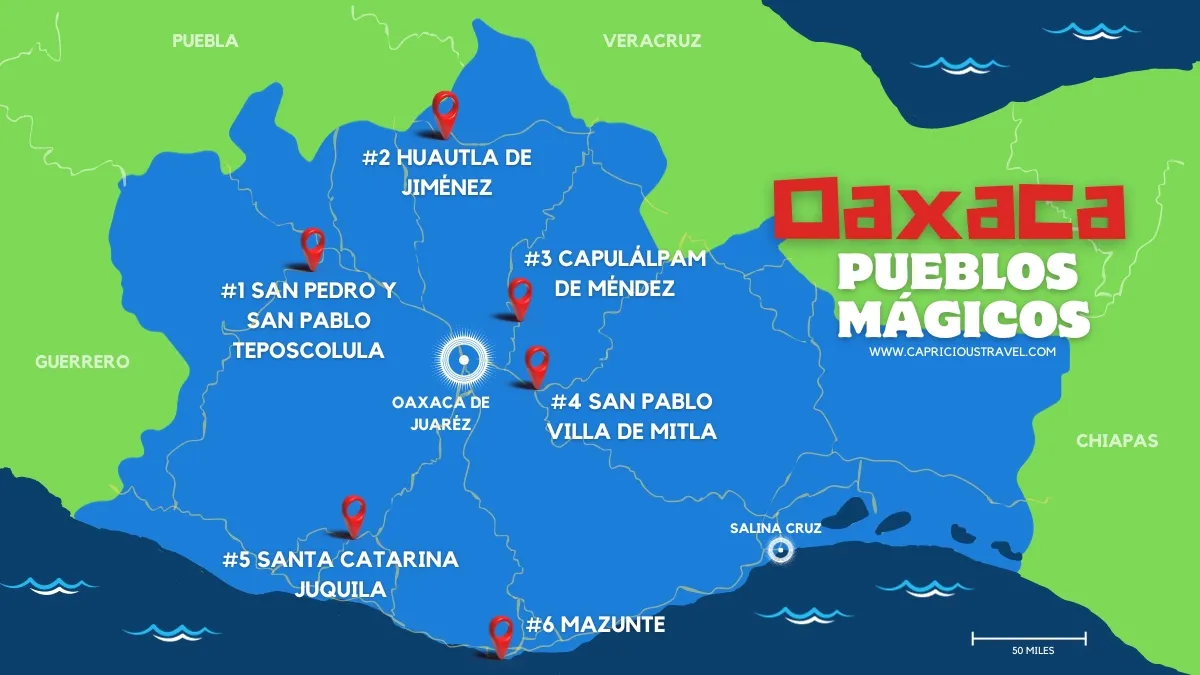
The six Oaxaca Pueblos Mágicos are fairly evenly spread out across the state of Oaxaca. The exception to this is the eastern Istmo region of Oaxaca, which doesn’t yet have any towns that have been designated as Pueblos Mágicos.
The map above sets out the location of each of the Oaxaca Pueblos Mágicos. Oaxaca de Juárez is located right in the center of the state and it’s the best place to base yourself if you’re keen to visit the northern Pueblos Mágicos.
As most of Oaxaca is mountainous, it makes sense that a majority of the Oaxaca Pueblos Mágicos are also located in mountain towns and villages. Mazunte is, of course, a very notable exception to that trend, as you’ll find out below.
Oaxaca Pueblos Mágicos: tHE ULTIMATE GUIDE
The 6 Oaxaca Pueblos Mágicos
Now that you know what Pueblos Mágicos are and where each of the six Oaxaca Pueblos Mágicos are located within the state of Oaxaca, I’ve set out below an in-depth guide to each of them.
In each section, I’ve included a description of each of the Oaxaca Pueblos Mágicos, the things to see and do, and the best way to get there.
Let’s get right into it.
1. San Pedro y San Pablo Teposcolula
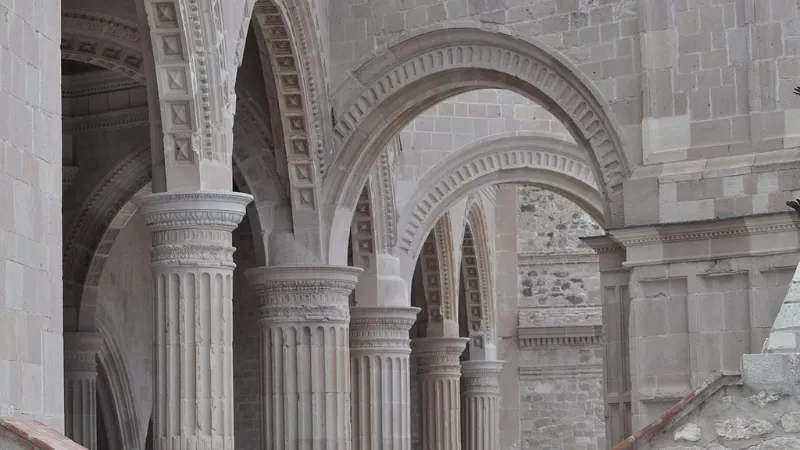
The town of San Pedro y San Pablo Teposcolula became a Pueblo Mágico in 2015. It’s one of the Oaxaca Pueblos Mágicos located in the mountains. It has an altitude of 6,560 ft (2,000 m) above sea level and is in the north-west of the state of Oaxaca, close to the border of the neighbouring state of Puebla.
Prior to the arrival of the Spanish, the town was an important trade center of the Mixtec people and the home of many of the Mixtec nobility. After the arrival of the Spanish, Dominican monks arrived and turned the town into one of the largest religious centers in Mexico.
The town’s name is quite a mouthful and it reflects the mix of indigenous and Spanish colonial history of the area. The original name of the town was Teposcolula. The additional words refer to the temple complex built after the arrival of the missionaries.
In modern times, Santa Catarina Juquila has eclipsed Teposcolula for religious importance, but the beautiful architecture of the historic buildings remains and makes this one of the most unique of the Oaxaca Pueblos Mágicos that you can visit.
Oaxaca Pueblos Mágicos: tHE ULTIMATE GUIDE
Attractions
There are several attractions in this Pueblo Mágico including the Templo de San Pedro y San Pablo, the Casa de la Cacica, Cerro de Pueblo Viejo, and El Alarcón.
I’ve set out more detail on each of these below.
Templo y Claustro de San Pedro y San Pablo Teposcolula
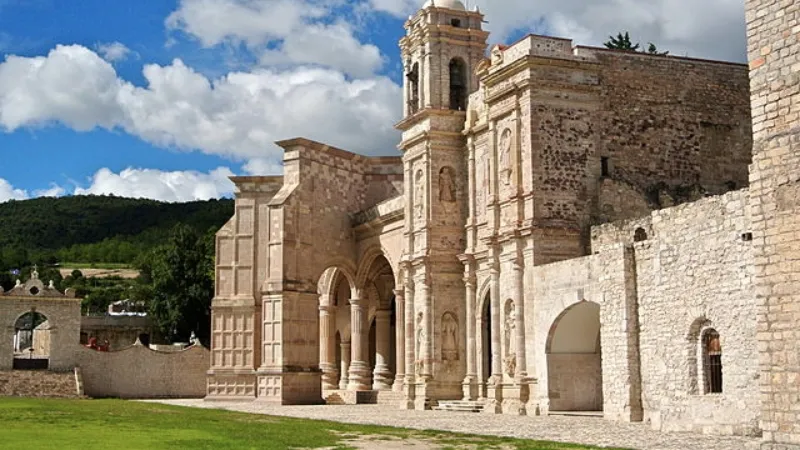
The most popular attraction of the town is the Templo y Claustro de San Pedro y San Pablo (Church and Closter of St Peter and St Paul). This large structure was built in the 16th century by Dominican monks as part of their missionary activities within what is now Oaxaca.
It’s a huge religious complex with both gothic and rennaisance influences and is famous for having the largest open chapel in Latin America.
Another attraction right next to the church grounds is La Capilla de Santa Gertrudis, a beautiful small chapel of gothic architecture with two floors and a small botanic garden.
Casa de la Cacica
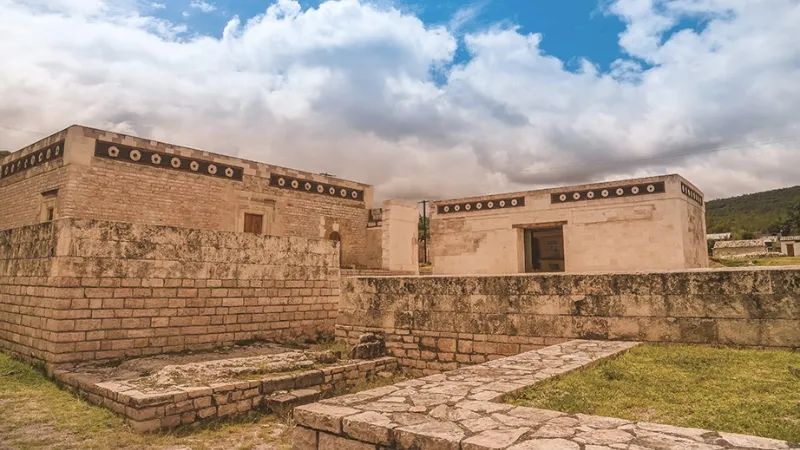
Another unique attraction in this Pueblo Mágico is Casa de la Cacica. It was the former home of the last Mixteca queen and was constructed around 1560.
The building is remarkable for its blend of Mixtec and Spanish architecture, which can be seen in the incorporation of distinctly Spanish architectural elements such as arches and balconies amongst the traditional Mixtec patterns and building materials.
If you enjoy historical architecture, la Casa de la Cacica is one of the few buildings in Latin America where an architectural transition from Mixtec to Spanish colonial architecture is so evident.
Cerro de Pueblo Viejo
A mile or so outside the city, you can visit an archaeological site on a hill called Cerro de Pueblo Viejo (literally “Old Town Hill”).
The hill is the site of a ruined Mixtec town that was believed to have been inhabited between about 1,000 to 1,550. Recent excavations have unearthed several residences, a central plaza and a ball court, evidencing the sophistication of the settlement.
The site has a small museum that also houses the Yucunama Codex (Códice de Yucunama), a rare Mixtec pictorial manuscript believed to have been published around 1520, just as the Spanish arrived in Mexico.
El Alarcón
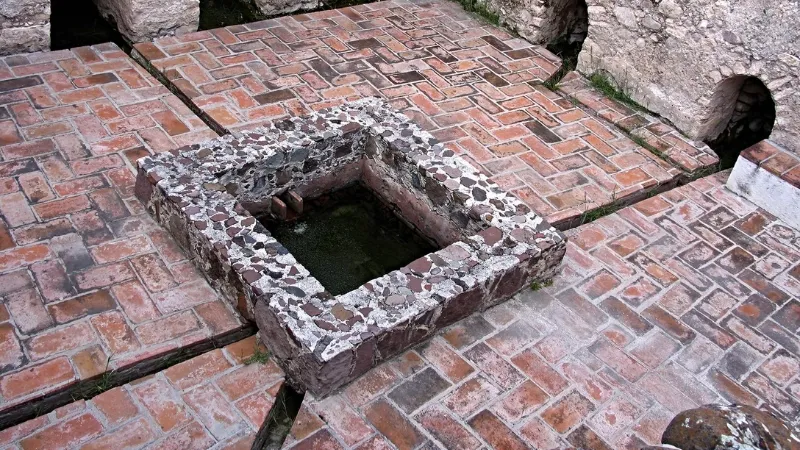
If you like ancient engineering, you definitely have to visit El Alarcón, which is part of a sophisticated water system that was constructed during the colonial period.
The water system carried clean water from various different mountain streams through stone channels into a network of cisterns in different parts of the community. There was also a separate conduit for used water.
El Alarcón is a remnant of that impressive ancient water distribution network of over 5 miles of stone aqueducts. Teposcolula is the only one of the Oaxaca Pueblos Mágicos to have this kind of attraction so if you like seeing ancient engineering marvels, this is a must.
Oaxaca Pueblos Mágicos: tHE ULTIMATE GUIDE
Best Way To Get There
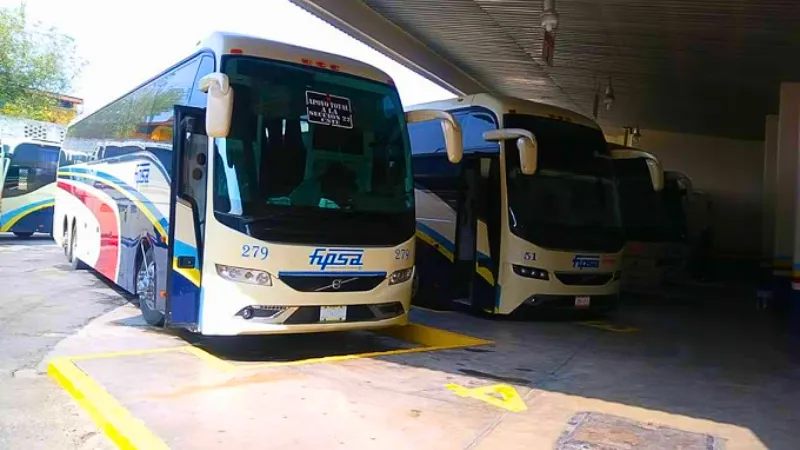
San Pedro y San Pablo Teposcolula is one of the northern Oaxaca Pueblos Mágicos and is located about 75 miles from Oaxaca City, and you have a few options to get there.
The road follows highways 190 and 1350 north toward Tehuacán and Puebla for most of the way before turning south on highway 125 for the last few miles into the town.
Rent a Car
If you can afford it, my recommendation would be to rent a car to visit this Pueblo Mágico.
A rental car will cost around US$30 per day plus gas, and you won’t need to rely on the bus. If you rent a car, you can reach Teposcolula in two hours. You’ll need a valid foreign driver’s licence.
You can rent a car in Oaxaca either downtown or at the airport at Europcar, Alamo and others. Use DiscoverCars to find the best deal available.
Bus
The other option is to take the bus. It’s definitely a more economical option, and you can expect to pay about US$5 – $10. Make sure you bring your Mexican pesos with you, as US dollars and credit cards won’t be accepted.
You’ll need to go to the second class bus station in the south-west of Oaxaca, opposite the large supplies market called the Central de Abastos.
The bus line you’ll need to take is called Fypsa, and there is usually one bus per day.
Oaxaca Pueblos Mágicos: tHE ULTIMATE GUIDE
2. Huautla de Jiménez

Of all of the Oaxaca Pueblos Mágicos, this one is the most difficult to reach. It’s situated 150 miles to the north of Oaxaca City in the mountainous region near the Pueblan border at an altitude of 6,900 ft (2,100 m). Huautla became one of the Oaxaca Pueblos Mágicos in 2015.
Huautla, or more formally Huautla de Jiménez, is best known for being the birthplace of María Sabina Magdalena García. María Sabina was a Mazatec shaman who became famous for her use of psychedelic mushrooms for medicinal purposes. Her home has become a museum that you can visit, and there is a monument to her in the town.
The town has retained its Mazatec roots, and many of its inhabitants still speak the Mazatec language and wear traditional Mazatec clothing, including the traditional colorful huipil. It’s also well-known in the caving community for having one of the deepest and most extensive cave systems in Latin America.
Oaxaca Pueblos Mágicos: tHE ULTIMATE GUIDE
Attractions
Attractions in this Pueblo Mágico include María Sabina’s home, the Cerro de la Adoración, Cascada Velo de Novia and Gruta de San Agustín.
I’ve set out more detail on each of these below.
María Sabina’s home
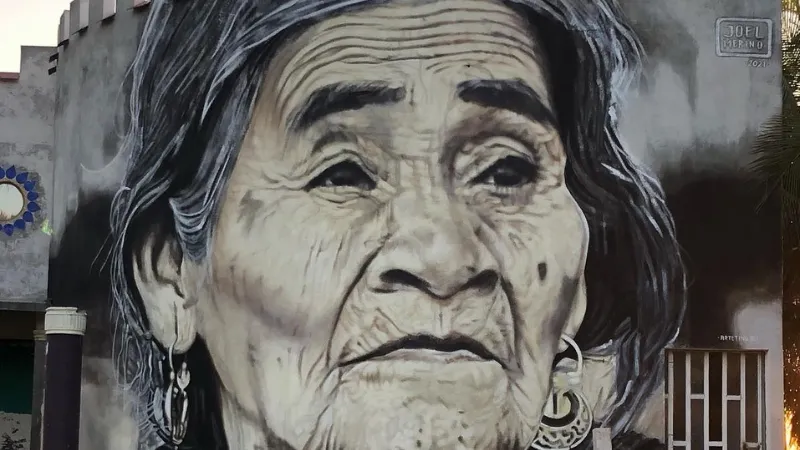
La Casa de María Sabina is on the south-eastern edge of the village. María Sabina lived and worked at the property for at least ten years, and it is now a museum open to the public in her honor.
On the walls of the property you’ll find images of famous people who visited her for cleansing treatments as well as paintings created by others who were inspired by her or their experiences during one of her cleansing treatments.
There is also a temazcal sauna in the garden behind the property.
Cerro de la Adoración

The Cerro de la Adoración (literally “Hill of Adoration”) is a hill just outside Huautla where local shamans go to be inspired and energised before performing their cleansing treatments.
The path up to the top of the hill begins a little way down the road from María Sabina’s house, so you can visit the Cerro de la Adoración before or after you visit María Sabina’s house.
Beyond its spiritual qualities, you can also get a great view of the town from the hilltop, which is particularly good at sunset or sunrise.
Gruta de San Agustín
About five miles to the east of Huautla, you’ll find the Gruta de San Agustín (the Grotto of San Agustín), believed to be the deepest and most extensive cave system in all of Latin America.
The cave system is up to a mile deep (1,546 m) and 35 miles (56 km) long and you’ll find waterfalls, underground lakes and enormous caverns.
If you’re considering exploring these cave systems and you’re not trained in caving, I strongly recommend that you hire a guide to accompany you. You should also ensure that people know when you are going and when you are due back, in case you get lost.
Cascada Velo de Novia
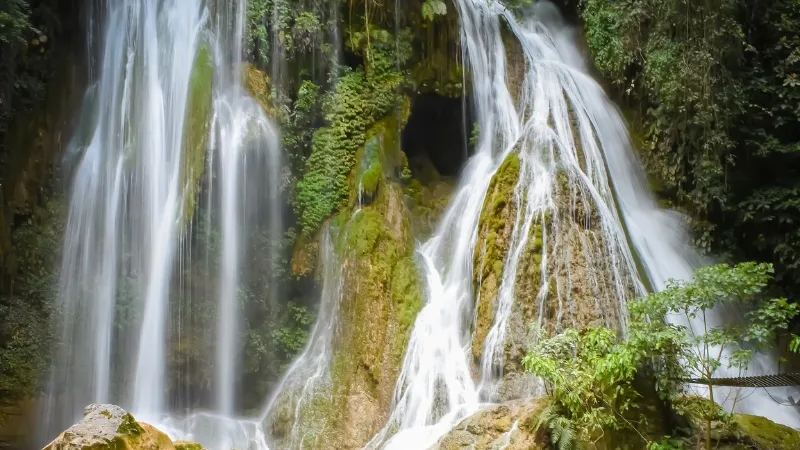
About five miles to the north of Huautla, you’ll find the beautiful Cascada Velo de Novia (literally, the Bridal Veil Waterfall). It takes its name from the fine, broad shape made by the water as it cascades its way over the edge of a round outcrop.
The waterfall isn’t far from the road and there’s an Indiana Jones-style suspended rope bridge that leads over a stream to the falls. It’s a great romantic spot for couples as well as for families travelling with children.
Oaxaca Pueblos Mágicos: tHE ULTIMATE GUIDE
Best Way To Get There
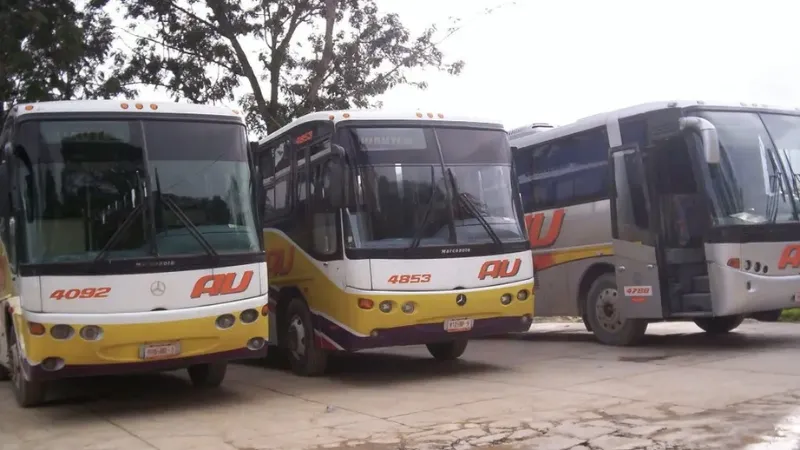
Huautla de Jiménez is about 150 miles from Oaxaca City, and despite being the most difficult of the Oaxaca Pueblos Mágicos to reach, you have a few options to get there.
There’s a more direct mountainous route along highway 135 and also a flatter route along highway 190. Both of them will get you to Huautla in around the same timeframe, even though the highway 190 route is 30 miles longer.
Rent a Car
As the most difficult to reach of all of the Oaxaca Pueblos Mágicos, if you can afford it, my recommendation would be to rent a car. It’s US$30 per day plus gas, and you won’t need to rely on the bus.
If you rent a car, you can reach it in a little over 5 hours. Use DiscoverCars to find the best deal available.
Bus
The other option is to take the bus.
Assuming that you’re travelling from Oaxaca, you’ll need to change buses in Tehuacán. You can get an ADO or AU bus from Oaxaca to Tehuacán for around US$35 and it will take around 3.5 hours. You’ll then need to change at Tehuacán and take a bus back to Huautla. AU operates that route and it will cost about US$10 and will take about 4.5 hours.
If you want to travel from Mexico City, Futura operates a direct service that will cost you around US$35 and will take about 7.5 hours.
Unless you really don’t like driving or don’t have a licence, I’d recommend renting a car. It will be both cheaper and quicker, especially with the time you’ll spend waiting to change buses.
Oaxaca Pueblos Mágicos: tHE ULTIMATE GUIDE
3. Capulálpam de Méndez
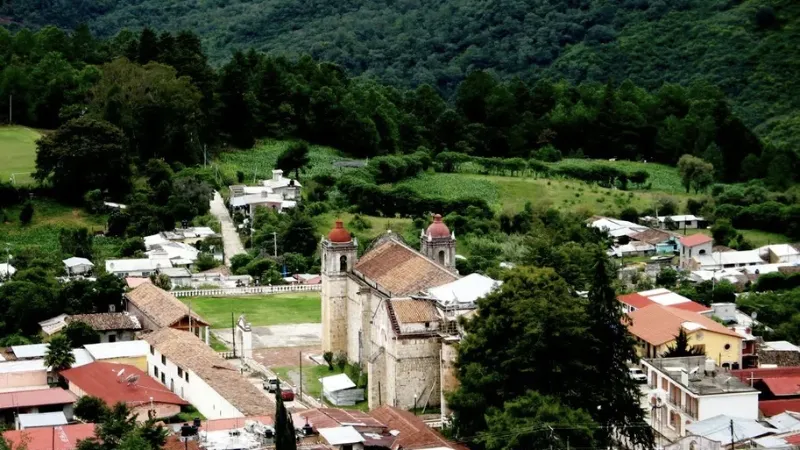
This is another one of the Oaxaca Pueblos Mágicos that is situated in the mountains, set at a height of about 6,700 ft (about 2,040 m) above sea level just under 50 miles from Oaxaca City.
The high altitude means that the town center is frequently covered by a thick, soupy mist that settles right down into the town square of an evening or a morning, resulting in the buildings seeming to float amongst the swirls of a misty sea.
Capulálpam has been one of the Oaxaca Pueblos Mágicos since 2007 and is known for its pre-hispanic traditions, its 16th century baroque church, beautiful adobe houses, and unspoilt natural environment.
Whether you’re here to experience local Zapotec traditions, the historic church and town square, or just to enjoy the natural beauty of the town and the surrounding mountains, you’ll love a visit to Capulálpam.
Oaxaca Pueblos Mágicos: tHE ULTIMATE GUIDE
Attractions
The attractions in Capulálpam include the Mirador de la Cruz, Centro de Medicina Indígena Tradicional, Cerro Pelado and the Centro Recretivo Los Sabinos.
Each of these are described below.
Templo de San Mateo
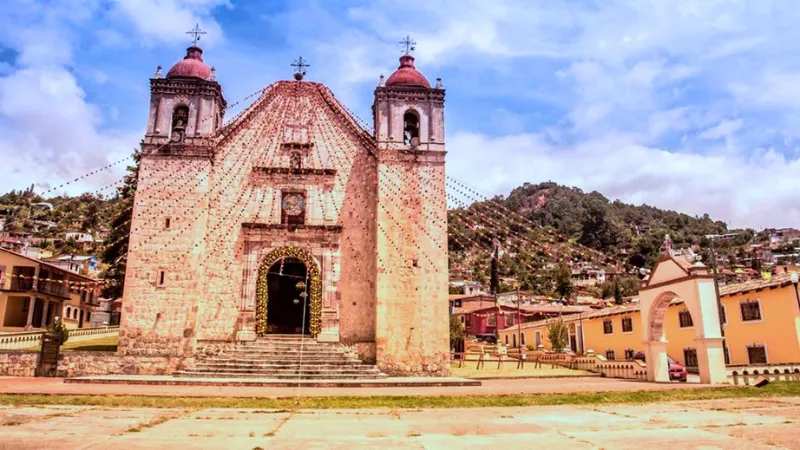
The centerpiece of the town is without a doubt its beautiful 16th century parish church, the Templo de San Mateo. It’s situated in the town square surrounded by cobblestoned streets and adobe houses with tiled roofs that rise up in steps as the hill ascends.
The church itself is somewhat simple and slightly austere from the outside, albeit still very beautiful. However, on the inside it’s richly decorated and has preserved the colorful fleur de lys motif of the original Dominican design.
The prized collection of the church is its 14 wooden altarpieces or retablos that span the entire Mexican Baroque from the 17th to the 18th centuries. While some of them were brought to the church from other parts of the Sierra Norte mountains, many were created in Capulálpam.
Mirador de la Cruz
About a 1/2 mile to the east of the town square, you can hike up the hill to the Mirador de la Cruz.
The Mirador de la Cruz is a lookout from which you can get a panoramic view of the town and the surrounding Sierra Norte mountains.
This is a much more relaxed hike than the route to Cerro Pelado, and it’s also a particularly good spot to enjoy the sunset. Make sure your phone has a torch function for the way back down.
Centro de Medicina Indígena Tradicional

Another attraction is the Center for Indigenous Medicine, which is a natural medical center that opened in 1995.
The center offers traditional remedies and treatments passed down through centuries of Zapotec culture and was the first of its kind in Mexico when it opened. At the center, you can receive massage treatments, temazcal cleanings, and browse the natural pharmacy for natural remedies such as ointments, teas and herbal compounds.
If you’re looking for hard-to-find natural health products that you can take home with you, this is the right place for you.
Cerro Pelado
If you’re feeling particularly adventurous, you can hike the 7.5 miles from Capulálpam up to Cerro Pelado, which is the summit of a nearby mountain.
It’s a slow but steady trek that will take you up to a quite literally breathtaking 9,000 feet, but you’ll be rewarded with a fantastic view when you make it.
There are also camping spots near the summit, so you don’t have a rush back or hike through the night if you don’t want to.
Centro Recretivo Los Sabinos
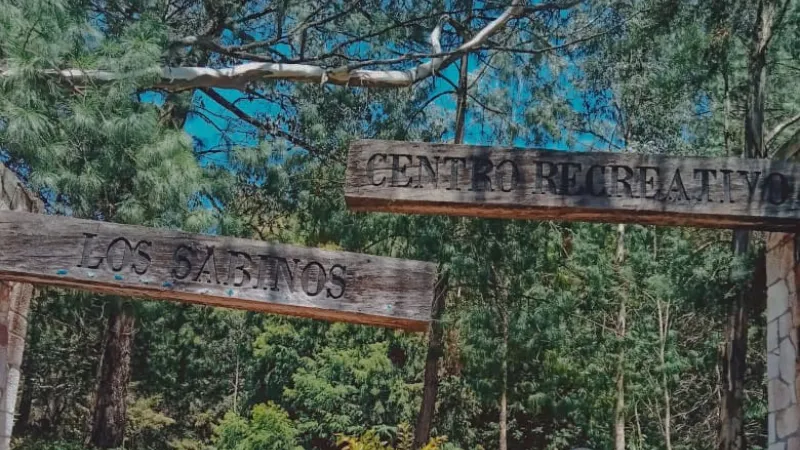
If you are looking for a place to camp or just a place to enjoy a walk under the trees, you should visit the Los Sabino Recreation Center.
It’s a small park area with a pond in the center surrounded by Montezuma cypress trees, known locally as “sabinos”. These are the same kind of trees as the famous Tule Tree in Santa María del Tule near Oaxaca, only much smaller.
This is a great family-friendly attraction with bathrooms and space for up to 100 people.
Oaxaca Pueblos Mágicos: tHE ULTIMATE GUIDE
Best Way To Get There
Capulálpam de Méndez is one of the easier to reach of the Oaxaca Pueblos Mágicos. It’s located about 50 miles north-east of Oaxaca City and you have a few options to get there.
Rent a Car
Although this one isn’t as hard to reach as some of the other Oaxaca Pueblos Mágicos, I still think that renting a car is the better option if you can afford it. It’s just the easiest way to get there and it only costs US$30 per day plus gas.
If you rent a car, you can reach it about 1.5 hours. Your route will take you a few miles east of Oaxaca before heading north on highway 175 to Ixtlán de Juárez. From there you’ll take a smaller road east for the last few miles into Capulálpam.
Use DiscoverCars to find the best rental car deal available.
Bus
The other option is to take the bus.
You can take a colectivo at the Oaxaca Macroplaza on highway 190 in the north of the city. You’ll need to find one with Ixtlán de Juárez marked on it and ask the driver if he will take you to Capulálpam. If you don’t speak Spanish, you’ll need to be patient and try to explain to the driver where you’re going and to agree a price.
If you’d prefer to take a bus, Cuenca and Autobuses Unidos both operate services to Ixtlán de Juárez from the Central de Autobuses (Central bus station) opposite the Centro de Abastos (central supply center) in the south-west of Oaxaca City. The trip will cost you about US$7.50 and will take between 1.5 hours to 2 hours.
Once you get to Ixtlán de Juárez, you’ll need to find a local taxi driver to take you the last few miles into Capulálpam.
Oaxaca Pueblos Mágicos: tHE ULTIMATE GUIDE
4. San Pablo Villa de Mitla
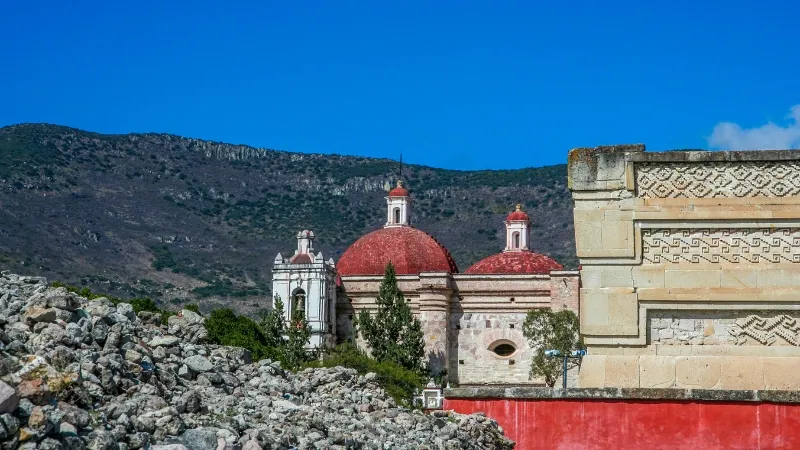
San Pablo Villa de Mitla is the easiest to reach of all of the Oaxaca Pueblos Mágicos and it’s the most visited for that reason. The reason for this is that it’s the closest to Oaxaca City of all the Oaxaca Pueblos Mágicos, just 30 miles further down the central valley to the west along highway 190.
Of all the Oaxaca Pueblos Mágicos, San Pablo Villa de Mitla has the most recognisable man-made attraction. It’s the site of the ruined Zapotec city of Mitla, more formally known as the Zona Arqueológica de Mitla.
It’s a great day-trip option from Oaxaca that is easy to do and enjoyable solo, as a couple or if you’re travelling as a family.
Oaxaca Pueblos Mágicos: tHE ULTIMATE GUIDE
Attractions
There are a few great attractions in San Pablo Villa de Mitla. At the Mitla site, you have Mitla itself as well as the Templo de San Pablo Apóstol.
Beyond that, you can also visit one of the local mezcal producers and can also go shopping in one of the many local clothing shops selling handmade products.
I’ve set out a little more detail on each of these options below.
Mitla
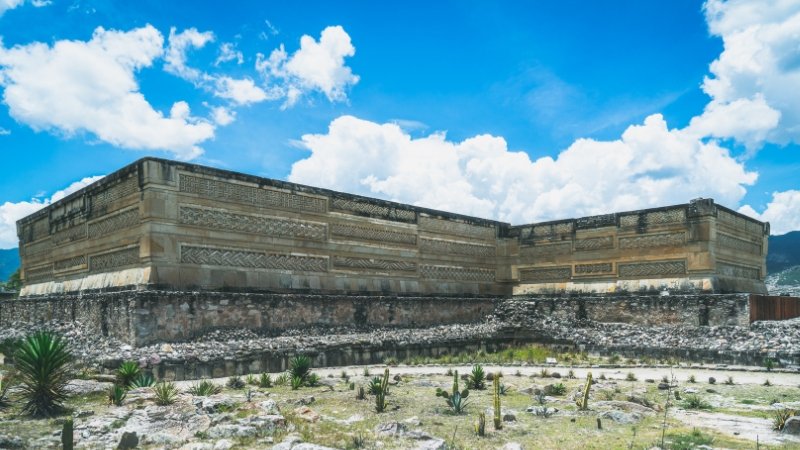
The obvious main attraction here is the ancient ruined Zapotec city of Mitla and it is principally this attraction that granted it entry to the club of the Oaxaca Pueblos Mágicos in 2015.
Mitla is believed to have been populated for nearly 2,000 years until the arrival of the Spanish in Mexico. The city gets its name from the Nahuatl word “Mictlán”, which means city of the dead. While that might sound a little grisly, the Zapotec people saw death as an important phase of life and the city was built as an important gateway between the world of the living and the underworld.
The city became a religious and cultural center that was at its peak when the Spanish arrived in 1521. Many noble Zapotecs were buried in the various tombs on the site, and there is a large open structure known as the palace or the grand hall.
The hall measures 120 ft by 21 ft (36.6 m by 6.4 m) and its unique feature is its six enormous central columns of volcanic stone which still stand after all these years, long after the roof that they supported is no more.
The interior and exterior walls of the various buildings all feature intricately designed stonework and friezes, often following a mosaic square-waved pattern known as Zapotec greco. The pattern is very well-known throughout Oaxaca and you’ll frequently see it incorporated into clothing, crafts and other artwork throughout the region.
You’ll need to pay 90 Mexican pesos (US$5) to enter the Mitla site.
Templo de San Pablo Apóstol
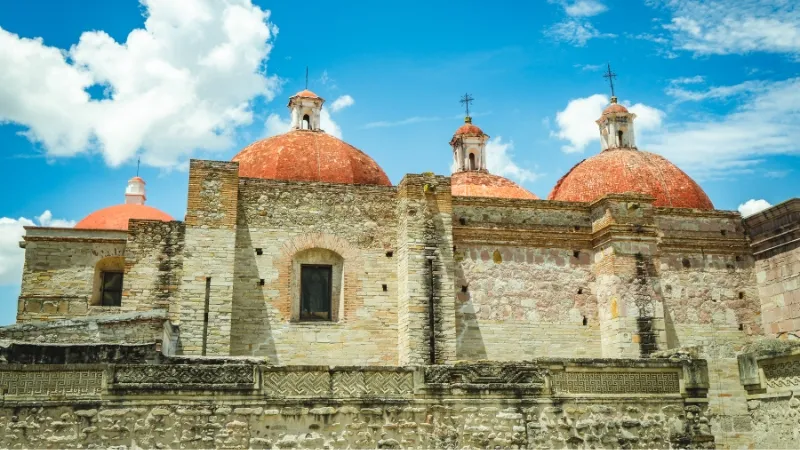
The Templo de San Pablo Apóstol is a small neo-Spanish church built on a corner of the Mitla site. However, the story of how and why it is there requires a brief journey back in history.
The Spanish arrived in Oaxaca in 1521, shortly after the fall of the Aztec stronghold of Tenochtitlan, now Mexico City. In November of that year, the Mixtec and Zapotec leaders agreed to submit to the Spanish invaders, so that Oaxaca was not subject to destruction the way that Tenochtitlan was.
However, not long after the arrival of the Spanish, religious Franciscans and Dominicans arrived with a mission to spread Christianity amongst the native population. Part of that exercise required the stamping out of the Zapotec religion, which was done by erecting Christian churches on or near sacred Zapotec sites.
As part of this effort, the newly-arrived Oaxacan Archbishop Albuquerque ordered the destruction of Mitla in 1561. The majority of the buildings were looted and torn down and all of its inhabitants were expelled. To drive the point home, the Templo de San Pablo Apóstol was constructed on the Mitla site using stone from the newly ruined Zapotec city.
The unusual manner of the church’s birth is evident in the architecture of the 16th century building. Although the signature red cupolas common to the style top the church, many of the walls features Zapotec patterns created in the stonework of the ruined city by its previous inhabitants.
Mitla and the Templo de San Pablo Apóstol are still to this day full of historical mystery. In the 17th century, a Dominican friar named Francisco de Burgoa who was born in Oaxaca wrote of a labyrinth of tunnels that were believed to exist beneath the Mitla site and lead to the gateway to the underworld. De Burgoa believed that the entrance was hidden beneath the main altar of the Templo de San Pablo Apóstol.
No archaeologist has ever been able to find this mythical labyrinth and the story was believed to be just a story. However, in 2022, archaeologists used ground-penetrating radar and other non-invasive techniques to identify what they believe could be passages and galleries a few feet below the ground level.
Whether or not the labyrinth exists, no trip to Mitla is complete in my view without a vist to both Mitla and the Templo de San Pablo Apóstol.
Try Some Locally Produced Mezcal
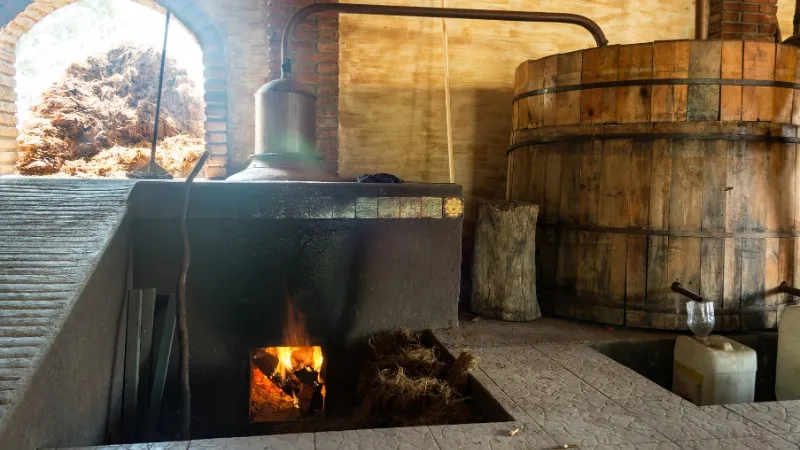
Oaxaca produces 90% of the mezcal that is made in Mexico and most of that is produced by families using traditional production methods in small towns like San Pablo Villa de Mitla.
Beyond being deeply integrated into the commercial life of the Oaxaca people, mezcal is also a key part of many Oaxacan traditions. It is used in healing rituals such as temazcal ceremonies, and is often consumed on special occasions including weddings and at funerals.
A trip to Oaxaca isn’t complete without learning about Oaxaca’s iconic and diverse spirit. Unlike tequila, which is made only from the blue agave, mezcal is produced from more than 30 different types of agave. If that seems a little overwhelming, there is an entire subculture of mezcal enthusiasts who work in local mezcalerías and who will be more than happy to help you choose.
So after you’ve experienced the magic of the Mitla ruins, I recommend that you visit a local mezcal producer or one of the many mezcalerías in and around San Pablo Villa de Mitla before you go back to Oaxaca City.
Shop For Handmade Clothes
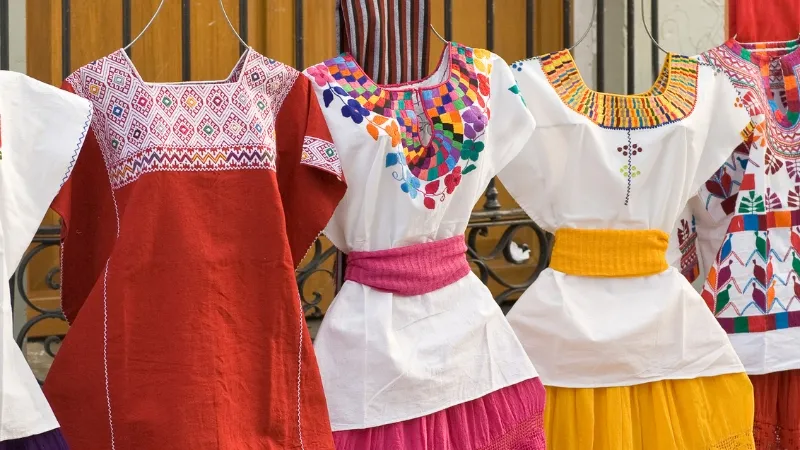
In addition to the vibrant traditional mezcal production in Oaxaca, textiles are also produced largely by families using looms to create beautiful handmade clothing.
You can find locally-made products in the Mercado de Artesanías near the Mitla ruins or you can go to visit one of the many tailors directly. There are dozens of clothes shops that produce and sell their own products along Calle Internacional and Calle Morelos on the way from Oaxaca City up to the Mitla site.
You can try Bía Beguug Textil Artesanal, Artelar, and Artesanías Arely to get you started.
Oaxaca Pueblos Mágicos: tHE ULTIMATE GUIDE
Best Way To Get There

San Pablo Villa de Mitla is about 30 miles east of Oaxaca City, and is the closest of all of the Oaxaca Pueblos Mágicos to the state capital. You have a few options to get there.
Rent a Car
Even though this one is the simplest to reach of all the Oaxaca Pueblos Mágicos, renting a car is still a great option. Hierve el Agua is nearby, and the Tule Tree is on the way as well, and you can visit them all on the same day if you have a rental car.
If you rent a car, you can reach it about an hour. You’ll follow highway 190 east and then turn off on Calle International a few miles out of San Pablo Villa de Mitla when highway 190 turns south.
Use DiscoverCars to find the best rental car deal available.
Bus
The other option is to take the bus.
You can take a colectivo at the baseball stadium on highway 190 called Estadio Eduardo Vasconcelos in the north of the city. Look out for one with Mitla marked on it. There’s a colectivo collection point next to the stadium, so you can also go directly to the collection point as well. Once again, if you don’t speak Spanish, you’ll need to be patient and try to explain to the driver where you’re going and to agree a price.
If you’d prefer to take a bus, Fypsa buses leave the Central de Autobuses (Central bus station) opposite the Centro de Abastos (central supply center) in the south-west of Oaxaca City. You can also take the bus outside the baseball stadium described above, because the route also follows highway 190. The trip will cost you about 20 Mexican pesos (around US$1) and will last about an hour.
Tour
Another great way to visit San Pablo Villa de Mitla is with a tour. It’s one of only two of the Oaxaca Pueblos Mágicos that you can easily visit with an organized tour.
There are lots of advantages to this. You can see lots of attractions in the same day, you don’t have to book your own transport, and you’ll likely learn something from the guide that you wouldn’t have known otherwise.
Take a look at the tours available on Viator. There are options that combine the Tule Tree, Hierve el Agua and a mezcal tour together with a visit to Mitla.
Oaxaca Pueblos Mágicos: tHE ULTIMATE GUIDE
5. Santa Catarina Juquila
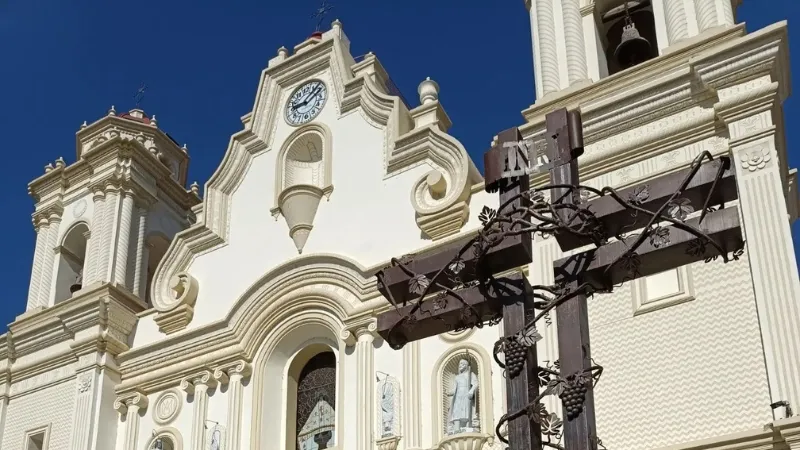
Santa Catarina Juquila is another of the Oaxaca Pueblos Mágicos situated in the mountains. It is known for its strong connection with Oaxacan traditions, particularly for its religious devotion to the Virgin of Juquila.
The town is located in the Sierra Madre del Sur mountains in the south of Oaxaca at an altitude of about 4,700 ft (1,432 m) above sea level. It’s 125 miles to the south-west of Oaxaca City and about 60 miles to the north-west of Puerto Escondido.
Santa Catarina Juquila has just over 8,000 people and it was founded in 1272. Christianity was brought to the town with the first missionaries in 1529 and since then it has developed into an important religious center. More so than any of the other Oaxaca Pueblos Mágicos, Juquila holds an integral place in the hearts of many Oaxacans.
Beyond its deep religious traditions, the town is also known for producing traditional Oaxacan clothing and for its beautiful surrounding natural environment.
Oaxaca Pueblos Mágicos: tHE ULTIMATE GUIDE
Attractions
The attractions in Juquila center around the town’s devotion to the Virgin of Juquila, which you can see in the Santuario de la Inmaculada Virgen de Juquila and the festivals held in her honor.
You can also check out some of the chatino designs of local tailors and visit the beautiful nearby Cascada Chorro Conejo.
I’ve set out some detail on each of these below.
Sanctuary of the Immaculate Virgin of Juquila
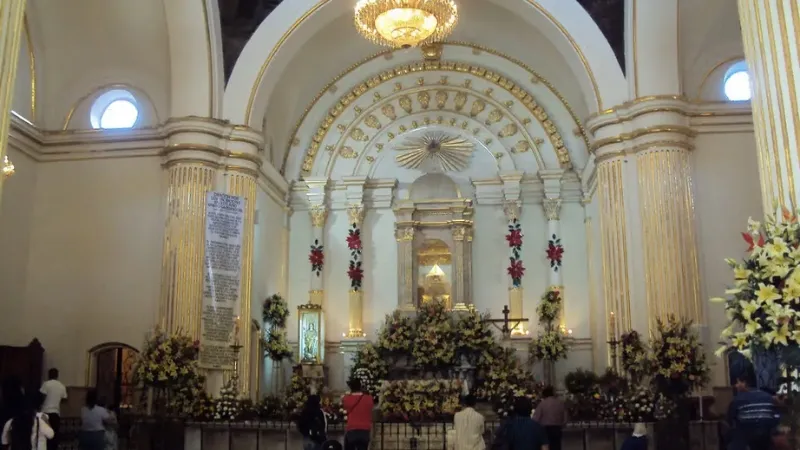
The Sanctuary of the Immaculate Virgin of Juquila (Santuario de la Inmaculada Virgen de Juquila) is an 18th century church located in the central plaza of Juquila. It was constructed in 1719 and is a beautiful example of late Mexican baroque architecture.
Despite its relatively small size, it has enormous religious significance in Oaxaca and Mexico more broadly. It is the final destination for many pilgrims along the “ruta de la fe” (route of faith) that begins just south of Oaxaca City in a village called Zimatlán de Álvarez and integrates 7 religious communities along the way.
Each year, well over a million people make a pilgrimage to the Santuario de la Inmaculada Virgen de Juquila to pay homage to the Virgin of Juquila. Visitors arrive all year round, so the chances are good that you will be able to see a religious procession or event in or in front of the church at some point during your visit.
However, if you want to be there when the town is at its most spectacular, you should be there on 8 December when the Fiesta de la Virgen de Juquila takes place. There are other festivals held at other times of the year, but if you want to see beautiful processions, listen to traditional music and be dazzled by colorful traditional clothing, this is to the time to be there.
Although most of the other Oaxaca Pueblos Mágicos have churches, this one is by far the most visited of any of them.
Chatinos Bordados (Embroidered Blouses)
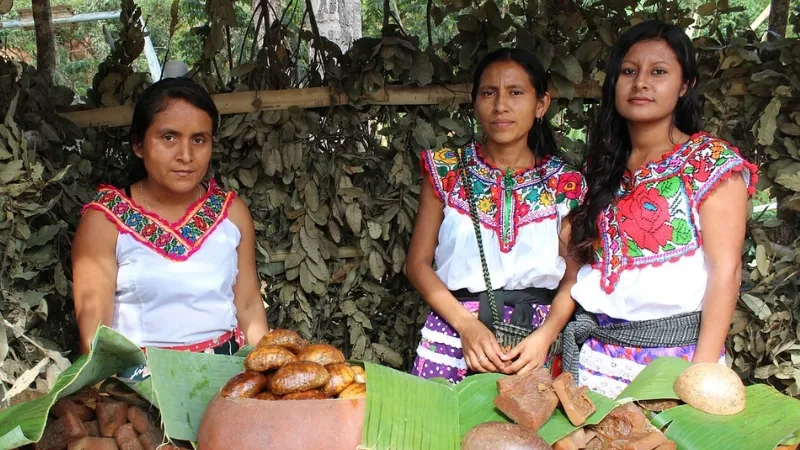
One of the most recognisable articles of clothing in Oaxaca are the wonderfully colorful blouses and skirts worn by many Oaxacan women. One of the most well-known of these are called “chatino” blouses, named after the Chatino people, many of whom live in Juquila and nearby Santiago Yaitepec.
Chatino blouses are known for their beautiful and intricate hand-embroidered floral patterns, called “chatinos bordados”. They were traditionally worn by the Chatino people, who also produce them by hand. In more modern times, they are worn by dancers in festivals like the Guelaguetza, which takes place immediately after the Fiesta de la Virgen de Juquila.
If you like the designs, you can speak to one of the many tailors in Juquila about designing and making some clothing for you, and you might even be able to watch them at work.
Cascada Chorro Conejo
Not far from the town center you can visit Cascada Chorro Conejo, a 100 ft (30 m) high waterfall where you can picnic and enjoy the sounds of the torrents of water shooting over the escarpment. You can also camp nearby in a designated area if you would like to.
In addition to the waterfall, there are also a few natural fresh-water streams nearby that you can visit and enjoy the peaceful natural environment.
Oaxaca Pueblos Mágicos: tHE ULTIMATE GUIDE
Best Way To Get There
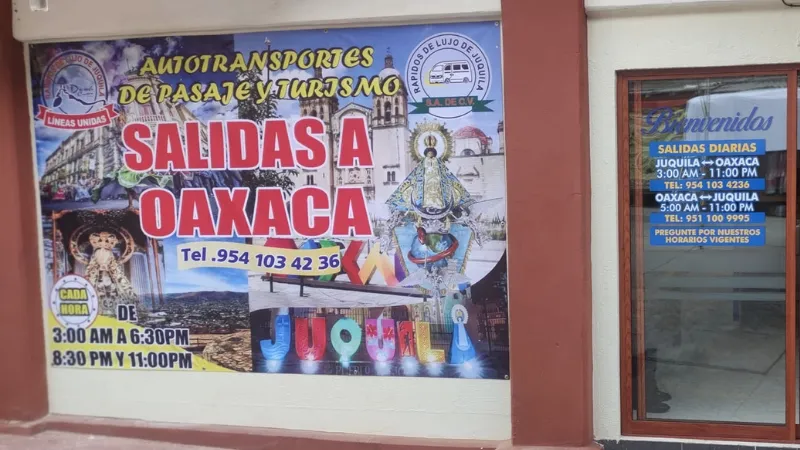
At about 125 miles south-west of Oaxaca City, Santa Catarina Juquila is one of the more distant of the Oaxaca Pueblos Mágicos from Oaxaca City. Howeve it’s only about 60 miles north-west of Puerto Escondido, and there are options to reach it from both.
Rent a Car
As this one is the more distant of the Oaxaca Pueblos Mágicos, renting a car is definitely the best option here if you can afford it. You can rent a car in both Puerto Escondido and Oaxaca and it will cost about US$30 per day plus gas in each case.
If you rent a car, you can reach it about 5 hours from Oaxaca and about 2 hours from Puerto Escondido. From Oaxaca, you’ll follow highway 131 south before turning west about 20 miles before you reach Juquila. From Puerto Escondido, it’s quicker to travel east on highway 200 along the coast for 30 miles and then turn north at Rio Grande o Piedra Parada.
Use DiscoverCars to find the best rental car deal available.
Bus
The other option is to take the bus.
Lineas Unidas de Juquila offers a minibus service between Oaxaca City and Santa Catarina Juquila along the route of faith (ruta de la fe). Buses usually depart several times a day. Contact them on the link above for their current timetable and pick-up and drop-off points.
Another option is Autotransportes Turisticos Santa Maria Juquila. They’re located on Calle Valerio Trujano in Oaxaca City and have services that depart each hour from 5am to noon.
In each case, the trip will take about 5 hours and will cost around 300 Mexican pesos (US$17.50).
Oaxaca Pueblos Mágicos: tHE ULTIMATE GUIDE
6. Mazunte
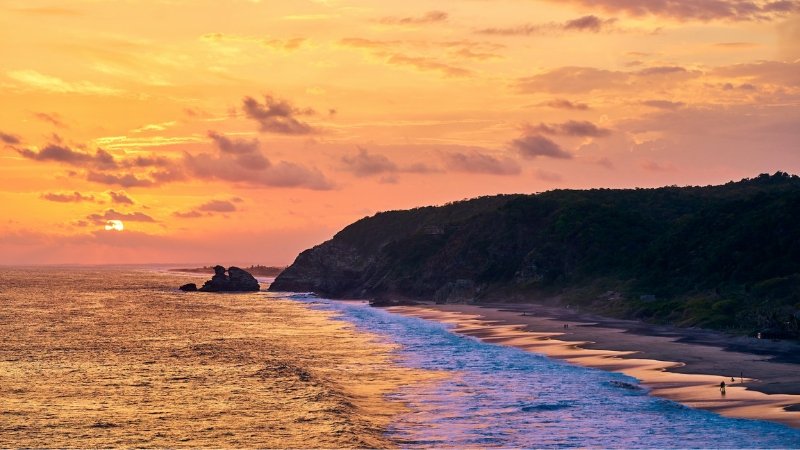
Mazunte is the most distinctive of the Oaxaca Pueblos Mágicos. While the other Oaxaca Pueblos Mágicos all have their natural beauty, Mazunte is the only one on the Pacific coast and it derives a lot of its magic from its glorious unspoiled beaches.
Older locals will tell you that the name of the town comes from the name of the mezontle crab that was once frequently found in the area. There is also a theory that the name comes from the Nahuatl language meaning something like “please lay eggs here”, likely a reference to the sea turtle population.
In any case, Mazunte’s magic was discovered many years ago by tourists and many, like Anita Roddick, the British founder of the Body Shop, fell in love with it. After Mazunte became one of the Oaxaca Pueblos Mágicos in 2015, it received a big boost in tourism and has now become an internationally recognized name.
Having said that though, it still has a relaxed small-town beach vibe and a modern reputation for being environmentally conscious.
Oaxaca Pueblos Mágicos: tHE ULTIMATE GUIDE
Attractions
Unsurprisingly, most of Mazunte’s attractions are down by the seaside. You can watch a sunset at Punta Cometa, swim or sunbathe on one of the many beautiful beaches, and visit the Mexican Turtle Center to learn about the town’s efforts to protect the local sea turtle population.
You can read about each of these in more detail below.
Punta Cometa

The “sunset walk” down to Punta Cometa is definitely one of the top attractions in Mazunte and definitely one that sets it apart from the other Oaxaca Pueblos Mágicos.
Punta Cometa is Oaxaca’s southern-most point and is known for being a wonderful place to watch the sun go down.
As you listen to the sound of the waves crashing against the rugged rocky outcrop, you can watch nature’s daily magic as the sun sets over the Pacific Ocean.
To reach it, you’ll need to take the “sunset walk”, which is about a mile long. You can join it at Playa Mazunte and you just walk down the hill to the rocks of Punta Cometa. It’s not well-lit, so make sure your phone has power and a torch-function for the walk back in the dark.
Beautiful Beaches

Mazunte has not shortage of beautiful beaches, another aspect that distinguishes it from the other Oaxaca Pueblos Mágicos.
Right in front of the Mazunte town center, you have Playa Mazunte (pictured), which is a swimmable beach with palapas and lots of bars and restaurants nearby.
To the west, you have the rocky outcrop of Punta Cometa, where the sunsets are amazing, as described above. On the other side of Punta Cometa you’ll find Playa Mermejita. Playa Mermejita isn’t safe for swimming, but it’s a long beautiful beach that it great for walking or relaxing and listening to the ocean.
To the east of Playa Mazunte, you have Playa Elefante, a small beach with fewer visitors that’s great for relaxing. Further to the east, you’ll reach Playa San Agustinillo, which tends to have an older demographic.
All of these beaches are absolutely gorgeous and have far less tourists than the more well-known and more easily accessible Puerto Escondido and Huatulco.
Centro Mexicano de la Tortuga
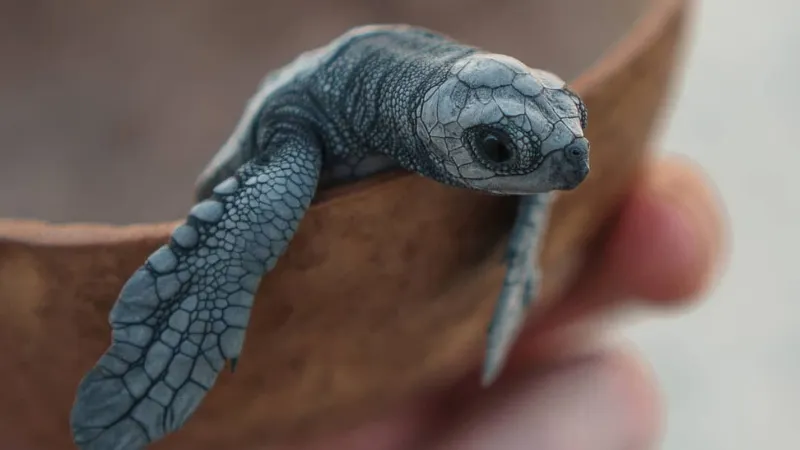
Mazunte has long been known for its sea turtle population.
Of the 7 types of sea turtles in the world, 6 of them visit Mexico, and 4 of those lay eggs on the Oaxaca coast near Mazunte. These 4 species are the Oliver Ridley Turtle, the Green Turtle, the Leatherback Turtle and the Hawksbill Turtle.
During the 1960s right up to the 1990s, the sea turtles that came ashore to lay eggs were hunted and their eggs, meat, and shells sold. The sea turtles formed a large part of the Mazunte economy, but the practice was stopped in the 1990s by the Mexican government when it became clear that the sea turtle population had been hunted close to extinction.
Since that time, Mazunte has taken action to protect the sea turtles arriving on its beaches and one of the initiatives to do this is the Centro Mexicano de la Tortuga (Mexican Center for Turtles), which opened its doors in 1991. The center has facilities for the incubation of turtle eggs, the care of baby and adult turtles and also the education of children and community about the plight of the sea turtles.
If you are interested in observing a heartwarming release of baby turtles back into the sea, you can also participate in a turtle release on most evenings throughout the year. Ask the center for information on the next release when you visit.
Their contact and entry details are below:
Oaxaca Pueblos Mágicos: tHE ULTIMATE GUIDE
Best Way To Get There

Mazunte is the farthest south of all of the Oaxaca Pueblos Mágicos. It’s about 164 miles (263km) from Oaxaca City, and about 40 miles from each of Puerto Escondido and Huatulco. Depending on where you are planning to base yourself, you have a few options to get there.
If you’re coming from Oaxaca, you’ll take highway 175 south the entire way. It’s a six-hour 164-mile journey through the Oaxaca valley and the mountains to the coast.
If you’re coming from Puerto Escondido or Huatulco, you’ll take highway 200 (which runs along the coastline) and turn south onto highway 175 for the run into Mazunte. It’s about 40 miles (65 km) and will take about an hour in either case.
If you’d like more detail on this, you can check out my comprehensive articles on each of these journeys below:
- Oaxaca to Mazunte: 7 Best Ways to Travel;
- Puerto Escondido to Mazunte: 5 Best Ways to Travel; and
- Huatulco to Mazunte: 5 Best Ways to Travel.
Rent a Car
Whether you plan to base yourself in Oaxaca City, Puerto Escondido or Huatulco, you can rent a car in any of the three of them for US$30 plus gas per day.
As with the other Oaxaca Pueblos Mágicos, renting a car is the easiest way to get around. That’s particularly the case on the coast, where there is far less public transport.
Use DiscoverCars to find the best rental car deal available.
Bus
The other option is to take the bus.
Lineas Unidas runs a service from Oaxaca to Zipolite, which is just a few miles along to the beach to the east. Once you arrive, you’ll just have to get a cab to take you to your hotel.
The trip will cost you about US$40 and will take around 7 hours. The Lineas Unidas buses depart from the Oaxaca historic center a few blocks south of the Zócalo.
Their contact details are below:
Tour
If you’re basing yourself in either Puerto Escondido or Huatulco and you just want to visit Mazunte for the day, you should definitely consider a tour to take the hassle out of organizing your travel arrangements.
There are tours from both Puerto Escondido and Huatulco that will take you to Punta Cometa, Playa Ventanilla and other attractions in Mazunte and will then take you back on the same day.
Take a look at the tours available on Viator.
Oaxaca Pueblos Mágicos: tHE ULTIMATE GUIDE
Which Are the Best Oaxaca Pueblos Mágicos?
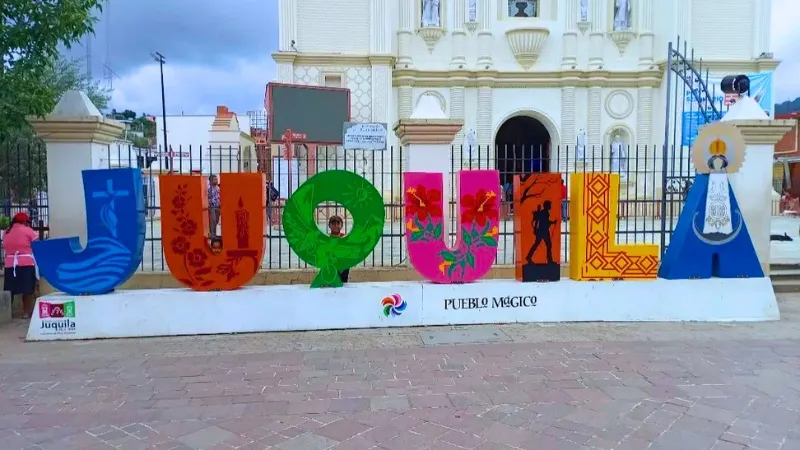
If you’re a little pressed for time, the most obvious of the Oaxaca Pueblos Mágicos to visit is San Pablo Villa de Mitla. It’s very close to Oaxaca City and you can do it as part of a tour along with other great attractions just outside Oaxaca City.
If you have children or prefer a beach holiday, then of all of the Oaxaca Pueblos Mágicos, Mazunte is a must. The beaches and rocky coastline are absolutely magnificent and the town has a laid-back Mexican beach-town vibe that will help to ease the stress out of your muscles.
But each of the Oaxaca Pueblos Mágicos has something special to offer, and they were given the designation of “magic town” for precisely that reason. Santa Catarina Juquila has its deep religious significance, Teposcolula and Capulálpam de Méndez have beautiful architecture, and Huautla has its unique Mazatec traditions.
So which is the best? The answer will depend very much on what aspects of the Oaxaca Pueblos Mágicos are most important to you personally. I’d recommend that you consider that and just let your gut guide you.
Oaxaca Pueblos Mágicos: tHE ULTIMATE GUIDE
Why Should You Visit Oaxaca?
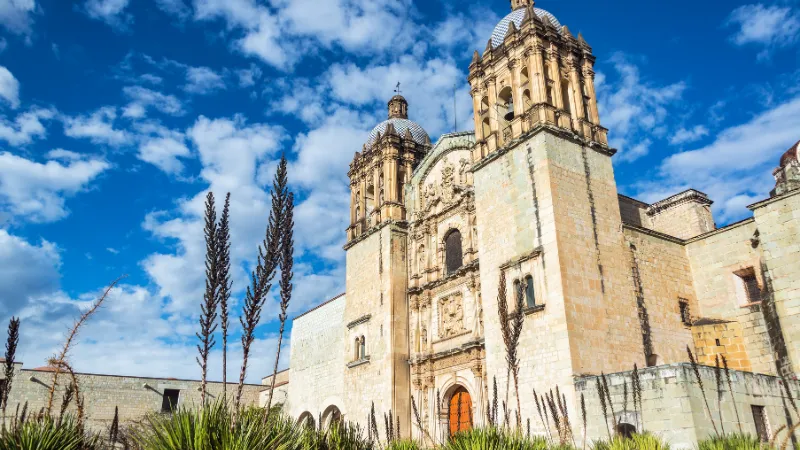
I hope that I’ve been able to convince you that you should visit the Oaxaca Pueblos Mágicos in particular and Oaxaca more generally. Oaxaca is one of the most culturally rich areas of Mexico with beautiful colors everywhere and wonderfully friendly people and it’s somewhere that should definitely be on your must-see list in Mexico.
As amazing as the Oaxaca Pueblos Mágicos are, they’re actually just the tip of the iceberg when it comes to Oaxaca. Just outside the city, you have Mitla in San Pablo Villa de Mitla and you can also visit nearby Hierve el Agua, the fantastic fossilized waterfalls with cool mineral pools that you can soak in. There are also lots of archaeological sites near Oaxaca City including Monte Albán where you can see more ruins of fascinating Zapotec cities.
The city itself is also captivating. It has hundreds of beautiful colorful buildings that are centuries old and constructed in the Spanish colonial style. Each year it also holds countless flamboyant traditional festivals including Day of the Dead, La Guelaguetza, and Noche de Rábanos.
And once you’ve explored the city, you could also travel south to visit Oaxaca’s idyllic pacific coast and explore some of its little-known ocean paradises including Puerto Escondido, Huatulco and the only one of the beachside Oaxaca Pueblos Mágicos, Mazunte.
All in all, I think that no trip to Mexico is complete without at least spending a few days in and around Oaxaca.
Oaxaca Pueblos Mágicos: tHE ULTIMATE GUIDE
How Do I Get To Oaxaca?
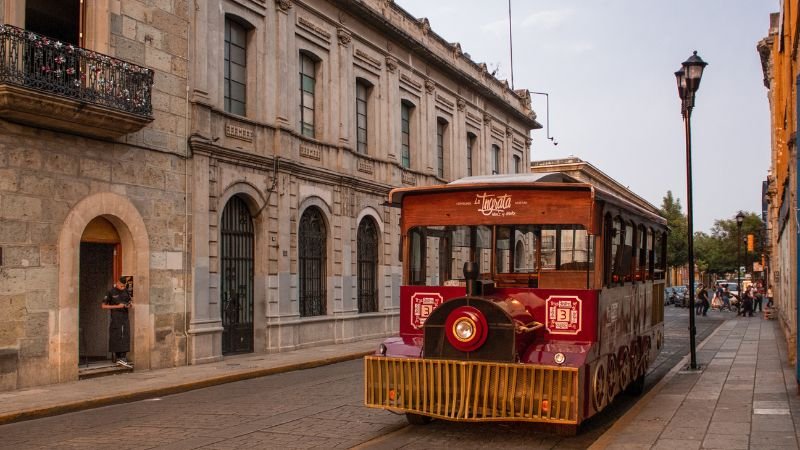
If I’ve persuaded you that you ought to be thinking about visiting Oaxaca and the Oaxaca Pueblos Mágicos, the next question that you probably have is how do you get there?
Well, while there are some direct flights to Oaxaca out of Dallas and Houston in Texas, the chances are good that you will fly into Mexico City on your way to Oaxaca. From there, you’ll need to decide how you want to get from Mexico City to Oaxaca.
You might fairly think that you’ll just change flights in Mexico City and fly the rest of the way to Oaxaca (and yes, Oaxaca does have an airport, called Xoxocotlán International Airport). If you’re pressed for time, that’s certainly the best option, and flight time is only one hour and twenty minutes.
However, you’ve actually got three options from which you can choose: plane, car, or bus. It’s too far to walk or cycle, there’s no train, and unless you want to go via Panamá, you can’t go by boat.
By plane, you can fly commercially or (if you can afford it) you can also fly privately. If you travel by car, you can drive yourself or hire a private driver. You can also take a tour for a day or two that is operated out of Mexico City.
In my view, the bus is great if you’re on a budget, and renting a car is perfect if you’re planning on doing a bit of a road trip to see the Oaxaca Pueblos Mágicos.
If you’re interested in finding out more, check out my article about the best way to get from Mexico City to Oaxaca.
Oaxaca Pueblos Mágicos: tHE ULTIMATE GUIDE
Where Are The Best Places To Stay In Oaxaca?
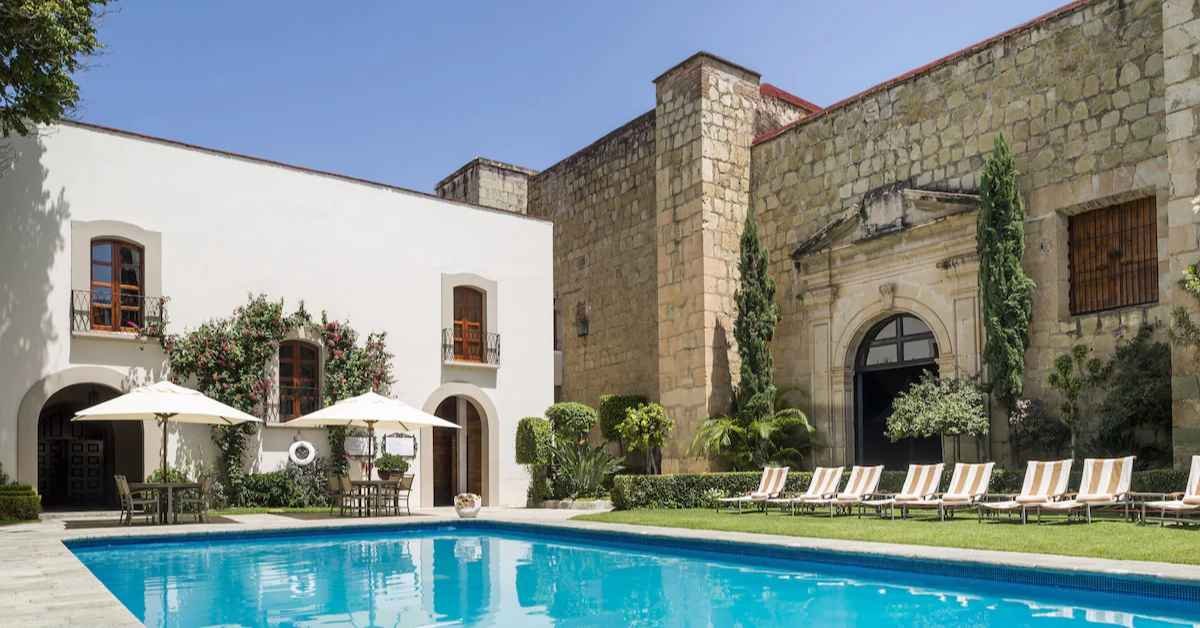
Now you know how to make it to Oaxaca to visit the Oaxaca Pueblos Mágicos, the next obvious question will be where do you stay?
Well, you’re in luck because Oaxaca has an amazing array of places to stay for you to choose from. Whatever your heart desires, you’ll find it in Oaxaca.
If you’re looking for a luxury hotel, I would start by looking at Quinta Real, Casa Santo Origen or the Grand Fiesta Americana.
If a boutique hotel is more your thing, then check out NaNa Vida Hotel Boutique, Casa Antonieta Oaxaca or Hotel Parador de Alcalá Oaxaca.
Check prices and availability at Booking.com or Expedia.com.
Oaxaca Pueblos Mágicos: tHE ULTIMATE GUIDE
When is the Best Time to Visit Oaxaca?

Oaxaca has a subtropical high-altitude climate, meaning that it typically has warms day and then cools off in the evenings.
There is also a dry season and a rainy season, with the rainy season lasting from June through to September.
The best time to visit therefore depends a little or your personal preference, but in my opinion, late October is the best time to visit Oaxaca. The days are warm, the nights are cool, and the city and outlying villages and Oaxaca Pueblos Mágicos are lively. You’ll also be able to see the Día de los Muertos festival, which is arguably better in Oaxaca that anywhere else in Mexico.
The downside, though, is that prices are expensive and the city is full of tourists doing exactly the same thing as you!
If you’re interested in finding out more about your options here, check my related article on the best time to visit Oaxaca.
Oaxaca Pueblos Mágicos: tHE ULTIMATE GUIDE
What Should I Pack To Go To Oaxaca?
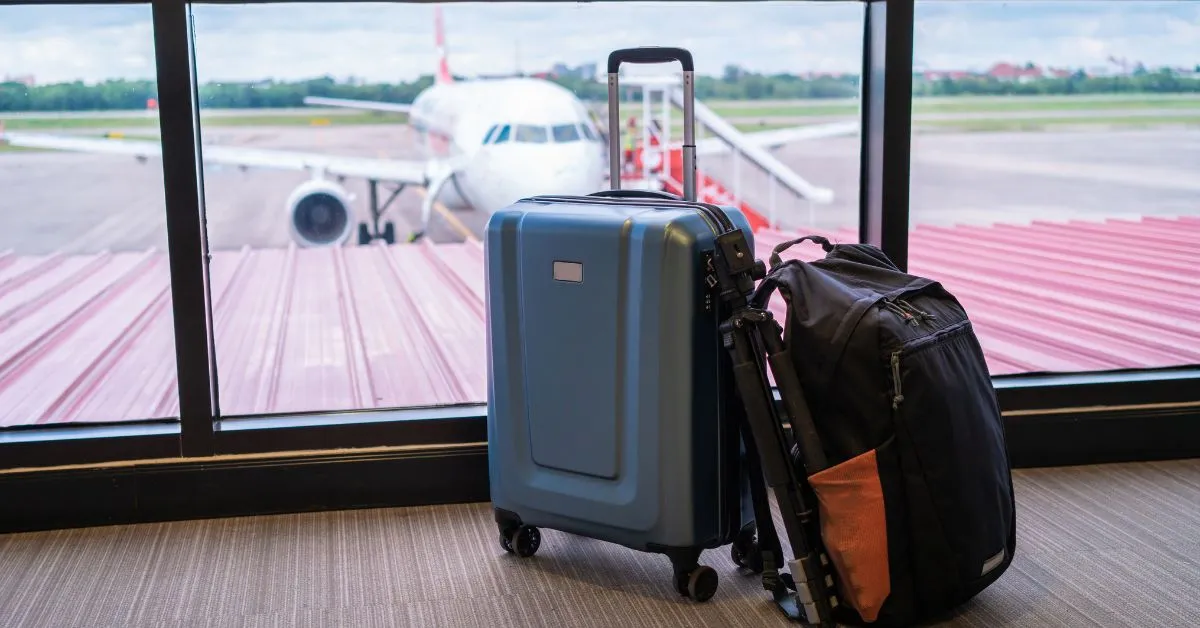
Oaxaca has warm days all year, with cool nights that become cold in the winter months of December through to February.
The temperature fluctuates during the day from around 49°F (10°C) to 85°F (30°C). Local Oaxacans deal with this by wearing layers. You put your sweater or jacket on in the morning and then take it off a few hours later when the sun has warmed everything up.
If you travel during the rainy season from June to September, you can also expect to have very humid days. After a heavy rain, it isn’t uncommon for the humidity to reach over 80%.
So, what should you pack? Whenever you travel, you should bring (or buy shortly after you arrive) a comfortable pair of walking shoes, a sun-hat, lot of light clothes for the day, and a light jacket or cardigan for the evenings.
If you travel in the winter months, you probably want to add a scarf to that list and opt for the slightly warmer jacket. This is also the case if you’re intending to visit the Oaxaca Pueblos Mágicos in the mountains.
If you’re going to travel in the rainy season (which can be a great way to spare your wallet!) you should include a few extra articles of clothing (because you can expect to get a bit sweaty) and a fold-up umbrella.
Oaxaca Pueblos Mágicos: tHE ULTIMATE GUIDE
Where Are The Best Oaxaca Beaches?

If you decide to visit Oaxaca’s pacific coast after you’ve seen the northern Oaxaca Pueblos Mágicos and all of the attractions in and around Oaxaca City, you’ve made a good call because Oaxaca has no shortage of amazing beaches.
Playa Mazunte and Playa Zipolite are laid-back beaches and Playa Zipolite even has a clothing optional area if that is your thing!
Playa La Entrega in Huatulco is known for its clear waters and coral reefs, making it a great spot for snorkeling and swimming.
If you’re looking for a place to surf, Playa Zicatela in Puerto Escondido is known for big sets, but if you’re looking for something in Puerto Escondido that is more relaxed, you can visit the sheltered cove of Playa Carrizalillo.
If you’re wondering what airport is closest to Oaxaca for flights to Puerto Escondido or Huatulco, it is still Xoxocotlán International Airport. Daily direct flights are available.
Check out my related article on Oaxaca’s best beaches if you’re interested in finding out more.
Oaxaca Pueblos Mágicos: tHE ULTIMATE GUIDE
Final Thoughts
If you’ve made it this far, thank you for reading and I hope I’ve been able to help you with information about the Oaxaca Pueblos Mágicos.
The Oaxaca Pueblos Mágicos are quite diverse, so you’ve got quite a bit of choice in which ones you visit. Whether your are looking for ancient ruins, beautiful sunny beaches, or traditions and religious homage, at least one of the Oaxaca Pueblos Mágicos will offer you some great attractions that you can enjoy whether you’re travelling alone, as a couple, with your friends or with your family.
If you’d never heard of the Oaxaca Pueblos Mágicos or Oaxaca before reading this and neither of them was really on your radar, I would strongly recommend reading a little more about Oaxaca before you lock up your itinerary.
I really do think that a trip to Oaxaca and one of the Oaxaca Pueblos Mágicos is a must on any trip to Mexico, even if you’ll only be in town for a few days.
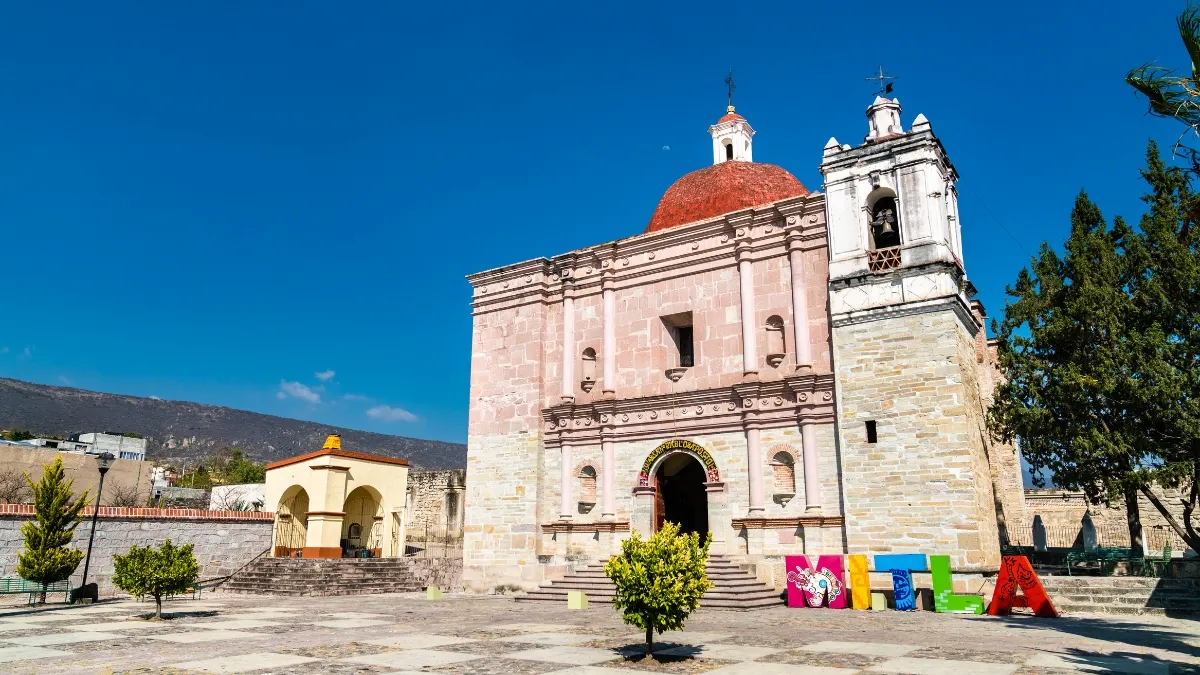
![Morelia to Mexico City: 7 Best Ways to Travel [2024]](https://capricioustravel.com/wp-content/uploads/2024/02/Morelia-to-Mexico-City-Morelia-Cathedral-and-Mexico-City-Metropolitan-Cathedral.webp)
![Hotel Azul Oaxaca: The Definitive Review [2024]](https://capricioustravel.com/wp-content/uploads/2023/11/Hotel-Azul-Oaxaca-Rooftop-Terrace-Bar-800x450.webp)
![Oaxaca To Puerto Escondido: 7 Best Ways To Travel [2024]](https://capricioustravel.com/wp-content/uploads/2023/09/How-to-Get-From-Oaxaca-to-Puerto-Escondido-1.webp)
![Morelia to Cancún: 5 Best Ways to Travel [2024]](https://capricioustravel.com/wp-content/uploads/2024/02/Morelia-to-Cancun-the-Morelia-Cathedral-and-the-Cancun-hotel-zone.webp)
![Oaxaca To Puebla: 7 Best Ways To Travel [2024]](https://capricioustravel.com/wp-content/uploads/2023/11/Oaxaca-to-Puebla-Puebla-Cathedral-800x450.webp)
![Is Guadalajara Safe to Visit? The Ultimate Guide [2024]](https://capricioustravel.com/wp-content/uploads/2024/02/Is-Guadalajara-Safe-Aerial-View-of-Guadalajara-Cathedral-.webp)